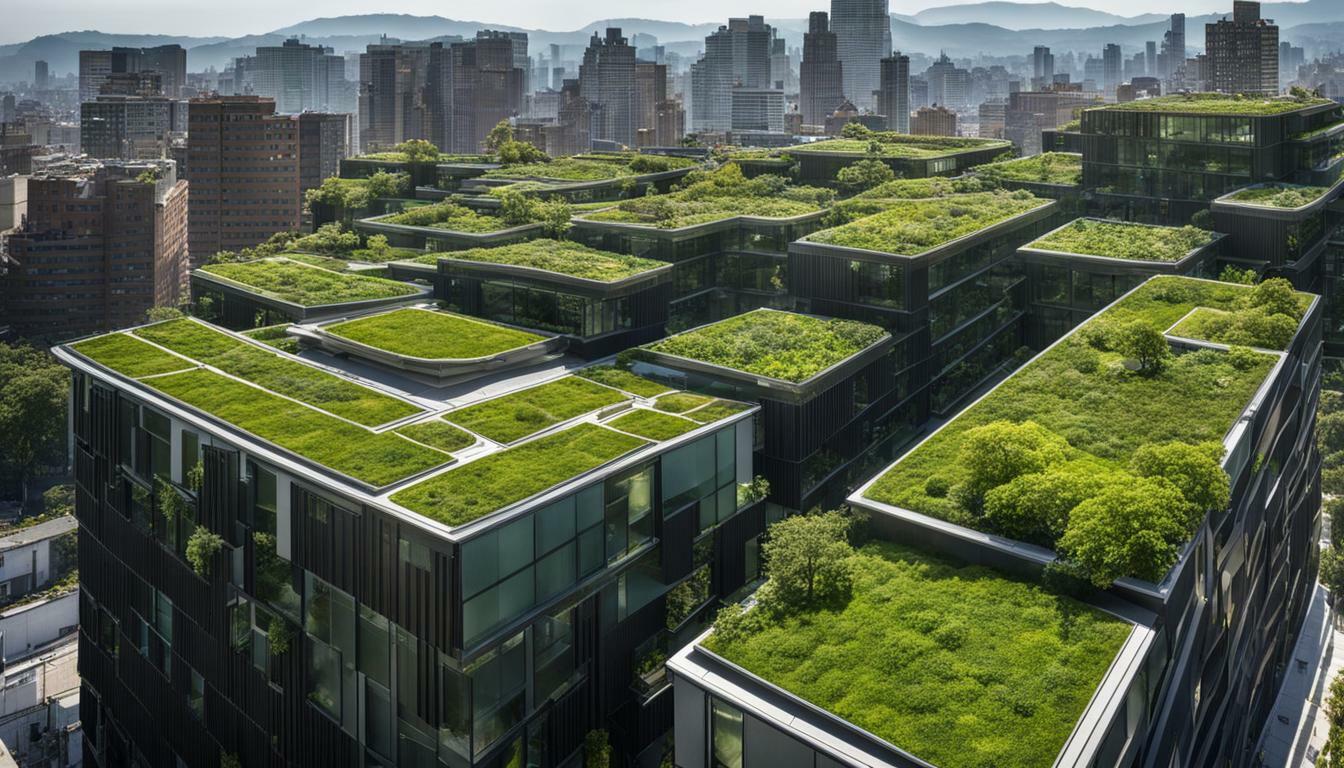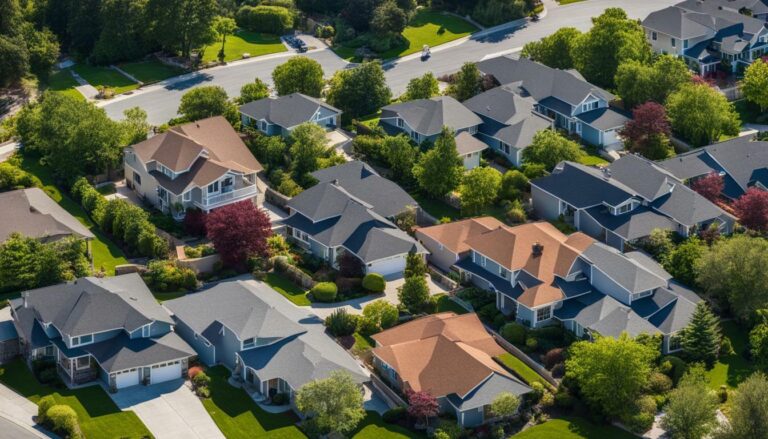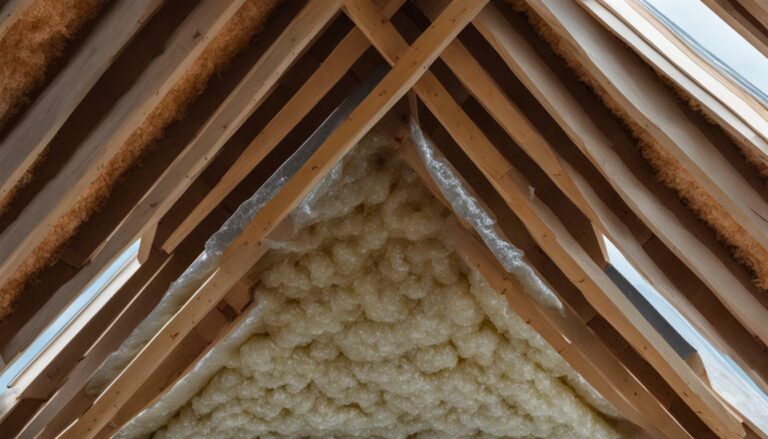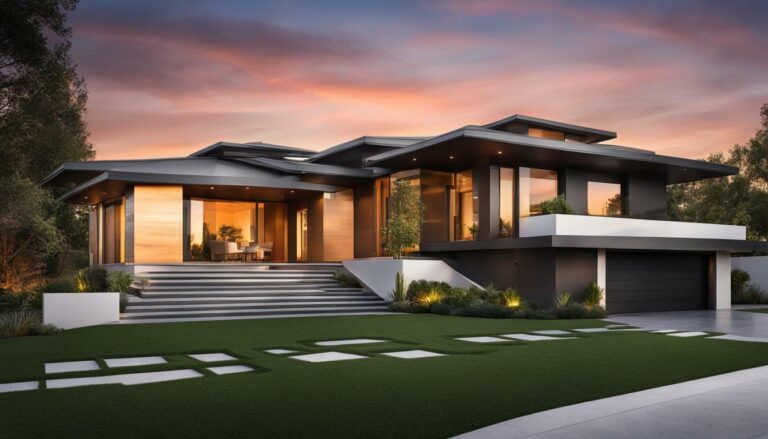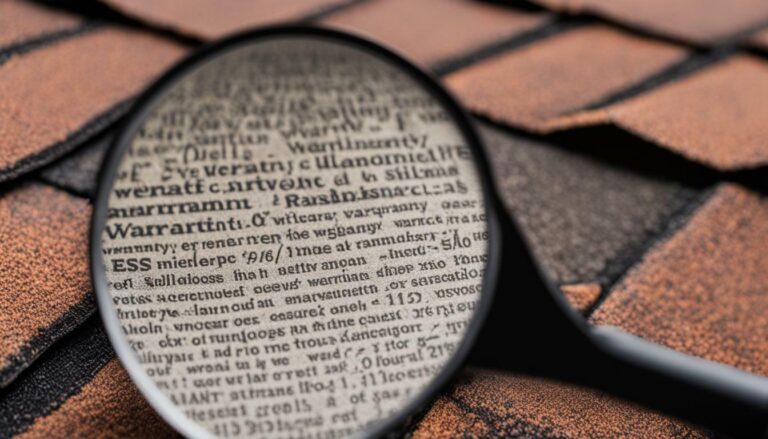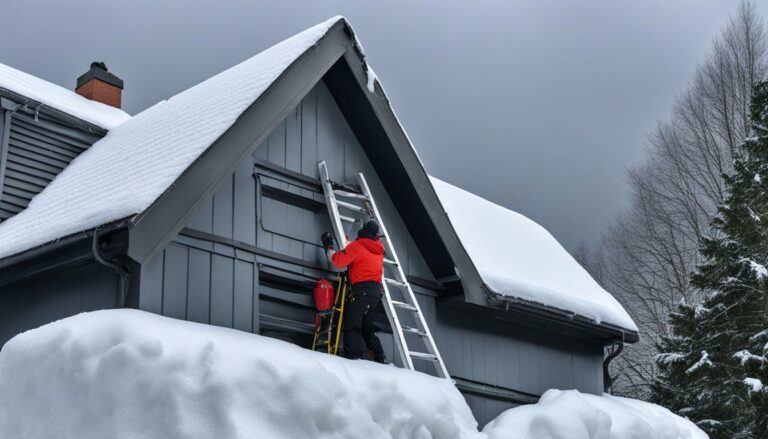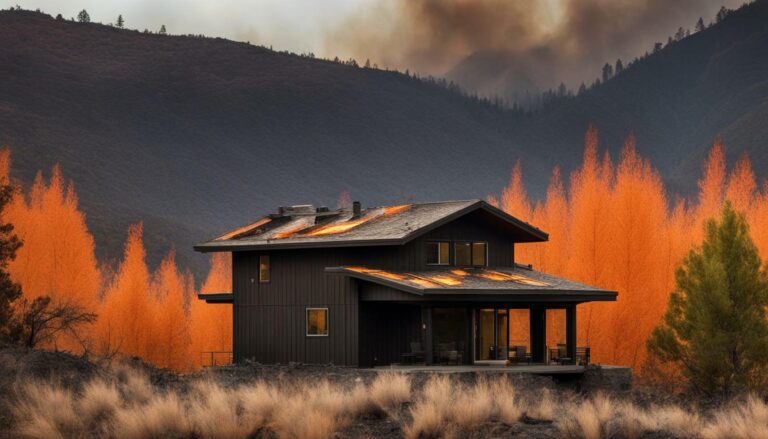Discover Green Roof Benefits for Urban Areas Today.
Green roofs offer a multitude of benefits for urban areas, creating a sustainable and eco-friendly solution for enhancing city living. Also known as vegetated roofs or living roofs, these innovative structures consist of a waterproofing membrane, soil, and vegetation on top of a traditional roof.
By incorporating green roofs into urban landscapes, cities can reap a wide range of advantages. From reducing stormwater runoff and lowering energy costs to increasing biodiversity and mitigating urban heat islands, green roofs play a crucial role in promoting a healthier and more resilient urban environment.
Key Takeaways:
- Green roofs provide numerous environmental, social, economic, and aesthetic benefits.
- They reduce stormwater runoff and lower energy costs.
- Green roofs enhance biodiversity and mitigate urban heat islands.
- They extend the lifespan of roofs and contribute to the beauty of buildings.
- Implementing green roofs can have positive cost-benefit analysis and potential returns on investment.
As cities strive for sustainability, the installation and maintenance of green roofs must follow best practices. This includes ensuring proper structural support, employing appropriate installation and maintenance techniques, and considering the unique challenges posed by historic buildings. The University of Denver serves as a successful case study, incorporating a green roof into its Community Commons building to support its sustainability goals and carbon neutrality efforts. However, building and maintaining green roofs in Denver’s climate can be challenging due to temperature fluctuations and freeze-thaw cycles. Therefore, careful selection of native plant species is essential to ensure their long-term viability in this specific region.
Understanding the Advantages of Green Roofs in Cities
Embracing green roofs in urban areas provides a range of advantages, contributing to the development of sustainable urban green infrastructure. Green roofs, also known as vegetated roofs or living roofs, offer a multitude of benefits that positively impact urban settings. By incorporating a waterproofing membrane, soil, and vegetation on top of traditional roofs, green roofs can revolutionize our cities.
One of the key advantages of green roofs is their ability to reduce stormwater runoff. By absorbing and filtering rainwater, green roofs prevent excessive water from overwhelming urban drainage systems. This not only reduces the risk of flooding but also improves the overall water quality in cities.
Furthermore, green roofs have a significant impact on urban heat islands. These islands are formed when cities absorb and retain heat, resulting in higher temperatures compared to surrounding rural areas. However, green roofs act as natural air conditioners, reducing the ambient temperature through evapotranspiration and shade. This cooling effect helps create more comfortable and livable urban environments.
Another advantage of green roofs is their ability to extend the lifespan of roofs. By acting as a protective layer, green roofs shield traditional roofs from weathering, UV radiation, and temperature fluctuations. This, in turn, reduces maintenance costs and increases the durability of roofs.
Moreover, green roofs enhance the biodiversity of urban areas. They serve as valuable habitats for plant and animal species, providing refuge and promoting ecological balance in concrete jungles. By supporting native plants, green roofs play a vital role in conserving urban biodiversity and reconnecting urban dwellers with nature.
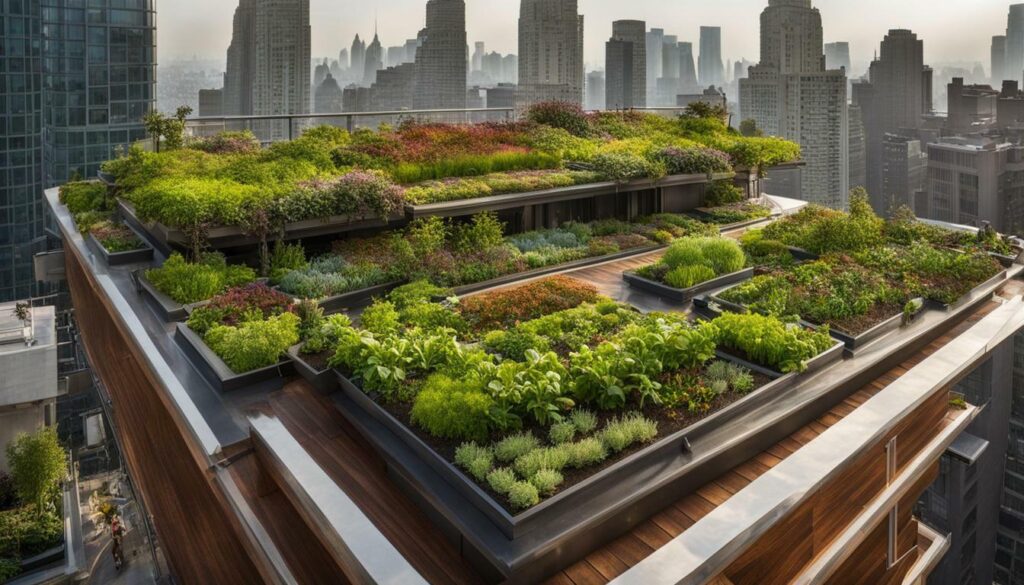
When considering the economic benefits, green roofs demonstrate a positive cost-benefit analysis. They can lower energy costs by insulating buildings, reducing the need for artificial heating and cooling systems. Additionally, green roofs increase the aesthetic value of buildings, making them more attractive to potential occupants and investors. These advantages, combined with potential paybacks and returns on investment, make green roofs a viable and sustainable solution for urban areas.
To ensure the long-term viability and effectiveness of green roofs, it is essential to follow best practices. This includes ensuring proper structural support, selecting appropriate plant species, and implementing regular maintenance routines. Additionally, historic buildings must be considered, as their unique characteristics may pose specific challenges when integrating green roofs.
Case Study: Green Roof Implementation at the University of Denver
A notable example of successful green roof implementation is found at the University of Denver’s Community Commons building. This green roof serves as a showcase for the campus’s commitment to sustainability and carbon neutrality. By incorporating native plants, the green roof not only enhances the aesthetics of the building but also contributes to local biodiversity.
| Advantages of Green Roofs | Summary |
|---|---|
| Reduces stormwater runoff | Prevents flooding and improves water quality |
| Mitigates urban heat islands | Cools the ambient temperature and enhances urban livability |
| Extends the lifespan of roofs | Protects roofs from weathering and reduces maintenance costs |
| Enhances urban biodiversity | Provides habitats for diverse plant and animal species |
| Offers economic benefits | Lowers energy costs and increases building attractiveness |
While embracing green roofs in urban areas presents numerous advantages, building and maintaining them in Denver’s climate can pose challenges. The fluctuating temperatures and freeze-thaw cycles in this region require careful selection of native plant species to ensure the long-term viability and success of green roofs.
Mitigating Urban Heat Islands with Green Roofs
Green roofs play a crucial role in combating the urban heat island effect, contributing to a more sustainable and livable urban environment. By covering traditional roofs with vegetation, green roofs help reduce the absorption and re-emission of heat, lowering surface temperatures in cities. This not only creates a more pleasant outdoor environment but also has significant implications for energy savings.
According to studies, green roofs can reduce the ambient temperature of urban areas by as much as 5 to 10 degrees Fahrenheit during the summer months. This cooling effect helps alleviate the strain on air conditioning systems, leading to reduced energy consumption and lower utility bills. In fact, research has shown that green roofs can reduce energy costs by up to 30% in buildings during peak summer periods.
In addition to their cooling benefits, green roofs also contribute to urban sustainability by reducing the need for additional stormwater infrastructure. The vegetation on green roofs absorbs rainwater, preventing it from overwhelming drainage systems and reducing the risk of flooding. By acting as natural sponges, green roofs can retain up to 70% of rainfall, releasing it slowly over time. This natural stormwater management system not only helps protect the city’s infrastructure but also improves water quality by filtering out pollutants.
To maximize the benefits of green roofs for urban heat island mitigation and stormwater management, careful consideration must be given to the selection of plant species. Native plants are often the best choice as they are adapted to the local climate and require less maintenance and irrigation. Native plantings can also provide habitat for birds and insects, enhancing urban biodiversity and creating a more vibrant and resilient ecosystem.
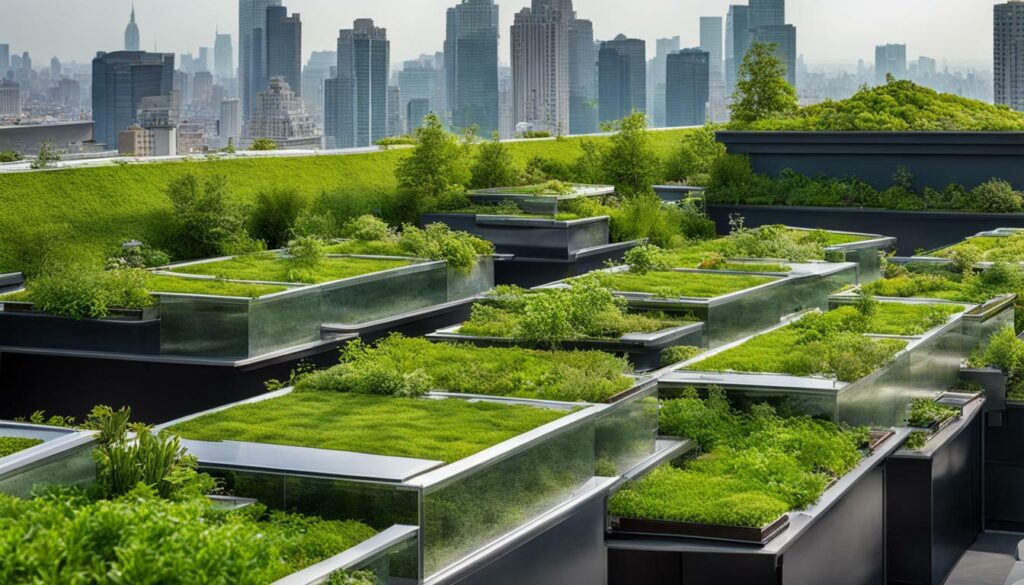
By incorporating green roofs into our cities, we can create a more sustainable and resilient urban environment. Their ability to mitigate the urban heat island effect, reduce energy costs, manage stormwater, and enhance biodiversity makes green roofs a valuable solution for urban areas. Implementing best practices in green roof installation and maintenance, such as ensuring structural support, proper soil depth, and regular inspections, is essential to their long-term success.
Managing Stormwater with Green Roofs in Urban Areas
Green roofs provide an effective solution for managing stormwater in urban areas, reducing the strain on existing stormwater infrastructure. By capturing and storing rainwater on the roof’s surface, green roofs help prevent excess water from overwhelming drainage systems and causing flooding. The vegetation and soil layers of green roofs act as natural sponges, absorbing rainfall and releasing it slowly over time.
The stormwater management benefits of green roofs are twofold. Firstly, they reduce the volume of stormwater runoff entering sewage systems, preventing overflows and water pollution. Secondly, they help improve water quality by filtering out pollutants and contaminants as the water is absorbed by the plants and soil. This not only benefits the local ecosystem but also safeguards the health and well-being of the communities.
Moreover, green roofs can significantly reduce the peak flow rates during heavy rainfall events, minimizing the burden on stormwater infrastructure and providing a more sustainable approach to urban water management. A study conducted by the University of Michigan found that green roofs can retain up to 70% of rainfall, depending on the design and vegetation density. This reduces the frequency and severity of urban flooding while promoting a more resilient and sustainable urban environment.
Case Study: Green Roof Implementation at the University of Denver
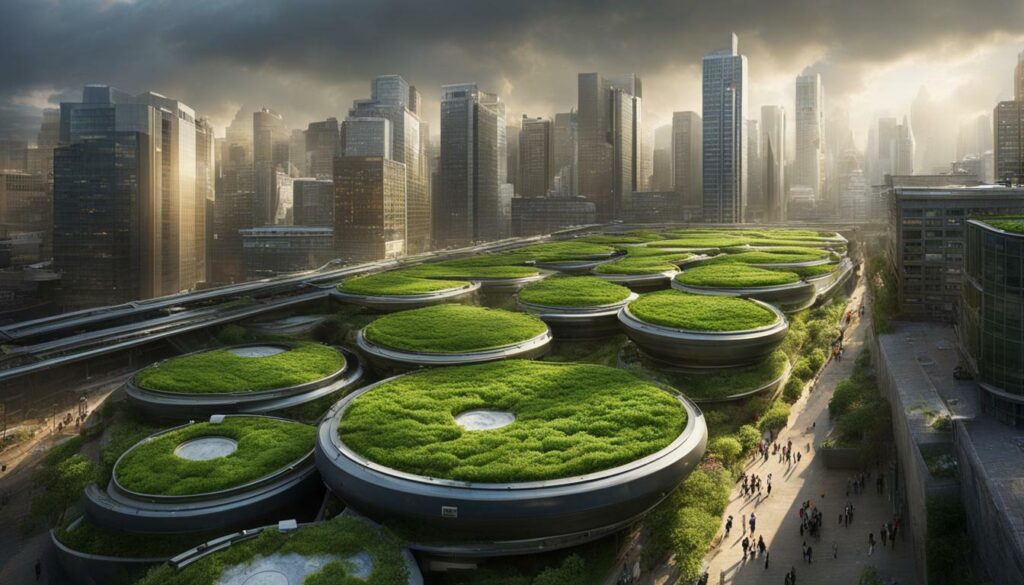
The University of Denver has taken a proactive approach to stormwater management by incorporating a green roof into its Community Commons building. This green roof acts as an innovative stormwater management tool, capturing rainwater and preventing it from entering the storm drainage system. By utilizing the natural absorption capabilities of plants and soil, the green roof helps reduce the impact of stormwater runoff on local waterways and infrastructure.
The green roof at the University of Denver is designed with a carefully selected mix of native plant species that can thrive in Denver’s challenging climate. This ensures long-term viability and helps maximize the stormwater management benefits. The roof serves as a showcase of sustainable design and reinforces the university’s commitment to environmental stewardship and carbon neutrality goals.
Green roofs not only provide a practical solution for stormwater management but also contribute to the overall resilience and sustainability of urban areas. As cities continue to face the challenges of climate change and urbanization, the implementation of green roofs can play a crucial role in creating more livable, environmentally-friendly, and water-responsible communities.
Extending the Lifespan of Urban Roofs with Green Roof Solutions
Incorporating green roofs into urban buildings not only brings environmental benefits but also extends the lifespan of roofs, reducing maintenance costs. Green roofs act as a protective layer, shielding the underlying roof structure from harsh weather conditions and UV radiation. This added layer of insulation helps to prevent roof degradation, such as cracking, blistering, and leaks, which can occur due to temperature fluctuations and exposure to the elements.
By reducing the impact of extreme weather conditions on the roof surface, green roofs can significantly extend their lifespan. Studies have shown that green roofs can double or even triple the lifespan of traditional roofs, resulting in long-term cost savings for building owners. The additional layer of vegetation and soil also provides a natural buffer against hail and heavy rainfall, minimizing the risk of damage to the roof structure.
Furthermore, green roofs help to regulate the internal temperature of buildings, reducing the strain on heating and cooling systems. This not only leads to energy savings but also reduces the need for frequent repairs and maintenance. The insulative properties of green roofs contribute to improved energy efficiency, resulting in lower utility bills and decreased carbon emissions.
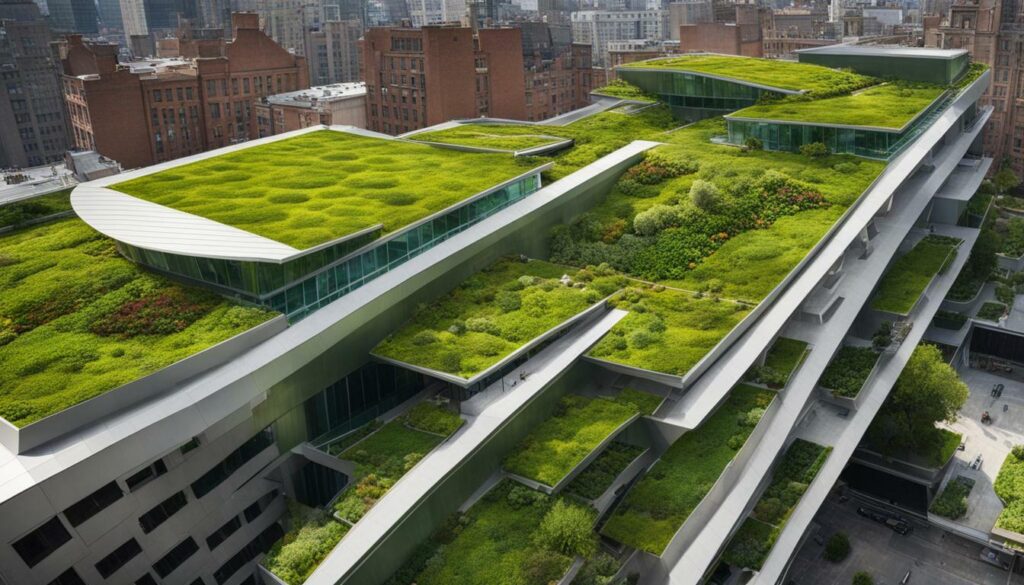
The benefits of green roofs for extending the lifespan of urban roofs are further supported by a study conducted by the University of Denver. Their green roof installation at the Community Commons building serves as a prime example. The green roof, featuring native plant species, not only enhances the aesthetics of the building but also contributes to the campus’s sustainability goals. By incorporating green roofs into their infrastructure, the University of Denver is taking proactive steps towards carbon neutrality and environmental responsibility.
However, building and maintaining green roofs in Denver’s climate can pose challenges due to rapid temperature changes and freeze-thaw cycles. It is crucial to select native plant species that are well-adapted to the local climate conditions to ensure the long-term viability and success of green roofs in these environments. Regular inspection, maintenance, and proper drainage systems are also essential to preserve the integrity of the roof structure and maximize the benefits of green roofs.
Table 1: Benefits of Green Roofs for Extending Roof Lifespan
| Advantages | Description |
|---|---|
| Increased Lifespan | Green roofs act as a protective layer, shielding roofs from weathering and extending their lifespan. |
| Reduced Maintenance Costs | By preventing roof degradation, green roofs minimize the need for frequent repairs and maintenance, resulting in cost savings. |
| Improved Energy Efficiency | The insulative properties of green roofs regulate building temperatures, reducing the strain on heating and cooling systems and lowering energy costs. |
| Environmental Benefits | Green roofs contribute to the overall sustainability of urban areas by reducing carbon emissions and promoting biodiversity. |
Enhancing Biodiversity in Urban Settings with Green Roofs
Green roofs act as havens for biodiversity in urban settings, providing a habitat for a range of plant and animal species. These vegetated rooftops offer a unique opportunity to create pockets of natural ecosystems amidst concrete jungles, promoting environmental sustainability and enhancing the overall quality of urban environments.
One of the key benefits of green roofs is their ability to support diverse plant life. The soil and vegetation layer on green roofs provide a substrate for various plant species, including native grasses, shrubs, and even trees. These plants not only beautify the urban landscape but also help purify the air by absorbing pollutants and releasing oxygen. Additionally, green roofs create microclimates that allow rare and endangered plant species to thrive, contributing to the conservation of biodiversity.
Furthermore, green roofs attract a wide array of animal species, including birds, butterflies, bees, and other beneficial insects. By providing a natural habitat in urban areas, green roofs play a vital role in preserving and supporting these populations. The diverse vegetation on green roofs provides food, shelter, and nesting opportunities, creating a sustainable and interconnected ecosystem within the city.
| Benefits of Green Roofs for Urban Biodiversity |
|---|
| Promote the growth of native plant species |
| Provide habitats for birds, butterflies, and beneficial insects |
| Contribute to the conservation of rare and endangered plant species |
| Create interconnected ecosystems within urban areas |
Preserving Urban Biodiversity through Green Roof Design
To maximize the biodiversity potential of green roofs, careful consideration must be given to design elements such as plant selection, water management, and connectivity. Choosing native plant species that are well-adapted to the local climate and soil conditions is crucial for supporting local wildlife. These native plants also require less maintenance and irrigation, reducing the overall environmental impact.
Water management is another essential aspect of green roof design. Incorporating features such as rainwater harvesting systems and irrigation techniques can ensure that the green roof habitats remain adequately hydrated, even during dry periods. The proper management of stormwater runoff not only benefits the green roof but also alleviates the burden on urban drainage systems.
Lastly, creating connectivity between green roofs and other green spaces within the city can facilitate the movement of animals and promote genetic diversity. This can be achieved through the integration of green corridors, birdhouses, and pollinator-friendly plants, fostering a network of interconnected habitats that span across the urban landscape.
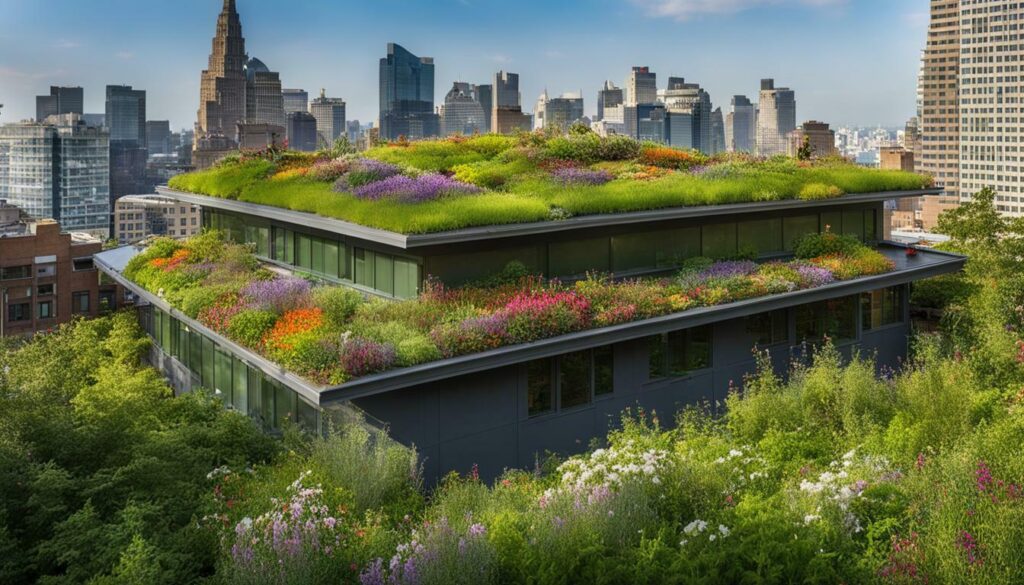
In conclusion, green roofs offer numerous benefits for enhancing urban biodiversity. By providing a habitat for diverse plant and animal species, green roofs contribute to the conservation of natural ecosystems within urban settings. Through thoughtful design and management practices, green roofs can serve as vital tools for creating sustainable and resilient cities that prioritize the well-being of both humans and the environment.
Exploring the Economic Benefits of Green Roofs in Urban Areas
Green roofs not only offer environmental advantages but also present significant economic benefits for urban areas. The implementation of green roofs can lead to cost savings and a promising return on investment. Let’s explore some of the ways that green roofs contribute to the economic well-being of cities.
One of the key economic benefits of green roofs is their ability to lower energy costs. Green roofs act as natural insulators, reducing the need for excessive heating in winter and air conditioning in summer. By providing an additional layer of insulation, green roofs can help regulate indoor temperatures, resulting in reduced energy consumption and lower utility bills for building owners. According to studies, green roofs can reduce energy usage by up to 30%, leading to substantial cost savings over time.
Furthermore, green roofs contribute to stormwater management, a critical aspect of urban infrastructure. They absorb rainfall and store excess water, mitigating the burden on stormwater systems and reducing the risk of flooding. This can help cities save on expensive infrastructure upgrades and repairs. Additionally, green roofs improve water quality by filtering pollutants from rainwater runoff, reducing the need for costly water treatment processes.
In addition to their environmental and stormwater management benefits, green roofs can also increase property values. Buildings with green roofs are seen as more desirable and attractive, leading to potential higher rents and property prices. Studies have shown that properties with green roofs can command a premium of up to 15% compared to similar buildings without green roofs. This presents a significant financial advantage for building owners and investors.
| Benefits of Green Roofs in Urban Areas | |
|---|---|
| Lower energy costs | Reduced need for heating and cooling |
| Stormwater management | Reduced burden on infrastructure and improved water quality |
| Increased property values | Potential higher rents and property prices |
Considering the environmental, social, and economic benefits, it is clear that green roofs are a wise investment for urban areas. Whether it’s promoting sustainability, improving quality of life, or enhancing property values, green roofs offer a multitude of advantages. The University of Denver’s Community Commons building provides a successful case study of the economic benefits of green roofs. By incorporating a green roof, the university has not only achieved its sustainability goals but also created a beautiful and environmentally friendly showcase for the campus.
While the economic benefits of green roofs are compelling, it’s important to recognize the unique challenges of building and maintaining green roofs in Denver’s climate. The city experiences dramatic temperature changes and freeze-thaw cycles, which can impact the longevity of green roofs. Careful selection of native plant species and appropriate maintenance practices are essential to ensure their long-term viability in such climates.
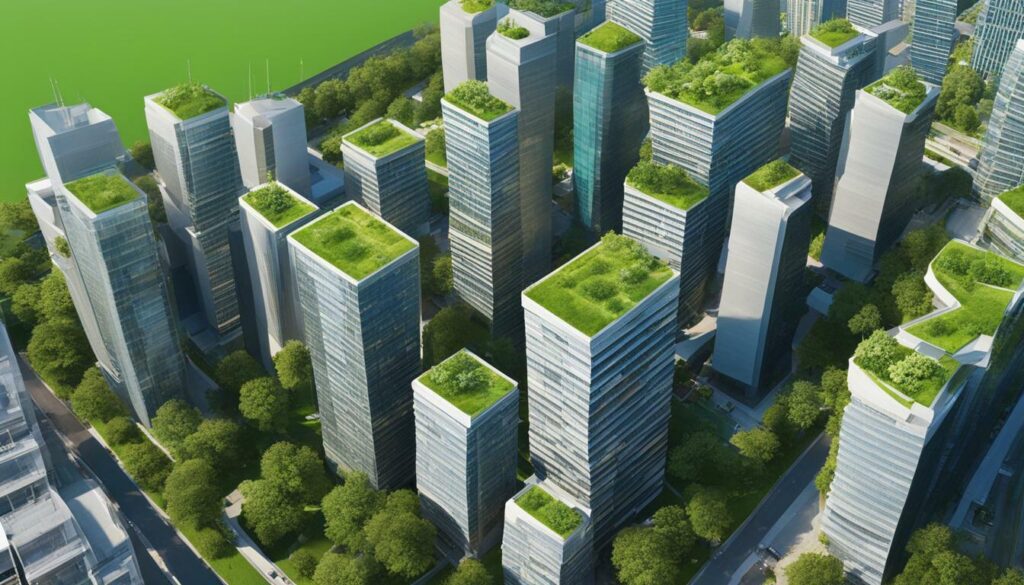
Conclusion
Green roofs not only contribute to a more sustainable and resilient urban environment but also provide significant economic benefits. From reducing energy costs and stormwater management to increasing property values, the positive cost-benefit analysis of green roofs makes them a worthwhile investment. As cities strive for sustainability and improved quality of life, green roofs offer a practical solution that delivers both environmental and economic advantages.
Best Practices for Green Roof Installation and Maintenance
To maximize the benefits of green roofs, it is essential to follow best practices for their installation and ongoing maintenance. Green roofs, also known as vegetated roofs or living roofs, provide numerous environmental, social, economic, and aesthetic benefits.
During the installation process, it is crucial to ensure that the structure of the building can support the additional weight of the green roof. Consulting with a structural engineer is recommended to evaluate the load-bearing capacity and make any necessary modifications.
Proper installation includes using a high-quality waterproofing membrane to prevent leaks and root penetration. The soil used should be well-drained and lightweight to minimize the weight load on the roof. It is also important to select native plant species that are adapted to the local climate and require minimal irrigation.
Ongoing maintenance is essential to ensure the long-term viability of green roofs. Regular inspections should be conducted to check for any signs of damage, such as leaks or vegetation overgrowth. Weeds and invasive species should be promptly removed to prevent them from overtaking the green roof ecosystem.
Regular irrigation is necessary, especially during dry periods, to ensure that the plants receive sufficient water. Fertilization should be done with caution to avoid overloading the ecosystem with nutrients. Pruning and trimming may be required to maintain the desired appearance and prevent any obstruction of drainage systems.
Following these best practices will help maximize the benefits of green roofs and ensure their longevity. Green roofs not only contribute to urban sustainability but also create beautiful and vibrant spaces that enhance the overall quality of life in urban areas.
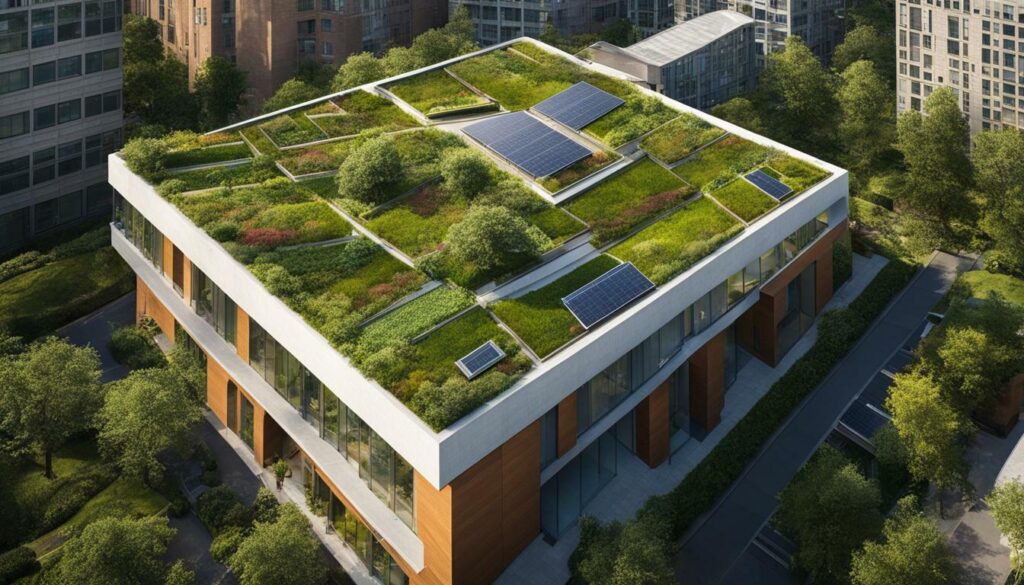
Case Study: Green Roof Implementation at the University of Denver
The University of Denver has made great strides in sustainability by incorporating a green roof into its Community Commons building, serving as a model for other institutions. Green roofs, also known as vegetated roofs or living roofs, provide numerous environmental, social, economic, and aesthetic benefits. They consist of a waterproofing membrane, soil, and vegetation on top of a traditional roof.
At the University of Denver, the green roof of the Community Commons building features native plants that not only enhance the beauty of the campus but also contribute to the university’s sustainability goals and carbon neutrality efforts. By using native plants, the green roof supports local biodiversity and requires minimal maintenance, making it a cost-effective and sustainable choice.
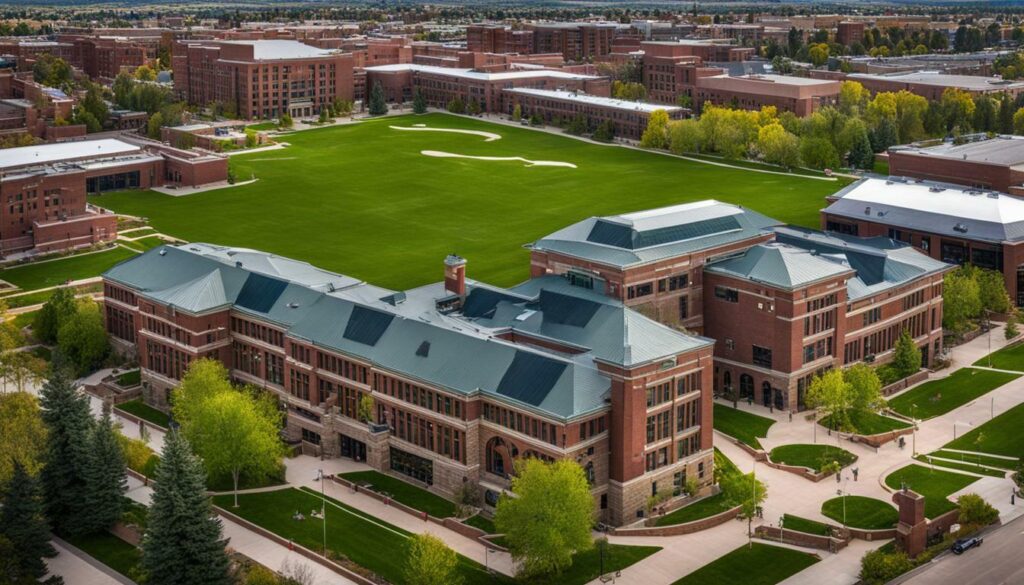
The green roof at the University of Denver’s Community Commons building serves as a showcase for the campus and demonstrates the university’s commitment to sustainability and environmental stewardship.
Benefits of the University of Denver Green Roof
The green roof at the University of Denver provides a range of benefits that positively impact the campus and surrounding environment. Some of these benefits include:
| Benefits | Description |
|---|---|
| Stormwater Management | The green roof helps reduce stormwater runoff by absorbing rainwater and reducing the burden on the existing drainage system. |
| Urban Heat Island Mitigation | The green roof helps mitigate the urban heat island effect by reducing ambient temperatures, creating a more comfortable environment. |
| Biodiversity Enhancement | The native plants on the green roof attract and support diverse species of plants and animals, contributing to urban biodiversity. |
| Energy Efficiency | The green roof helps regulate indoor temperatures, reducing the need for artificial cooling in the summer and heating in the winter, leading to lower energy costs. |
| Roof Longevity | The green roof protects the underlying roof membrane from weathering, extending its lifespan and reducing maintenance costs. |
The green roof at the University of Denver’s Community Commons building is a clear example of how green roofs can be successfully integrated into urban environments, providing multiple benefits for both the institution and the surrounding community. With careful planning, proper installation, and ongoing maintenance, green roofs can contribute to building sustainable and resilient cities.
Overcoming Challenges of Building and Maintaining Green Roofs in Denver’s Climate
Building and maintaining green roofs in Denver’s climate presents unique challenges due to dramatic temperature changes and freeze-thaw cycles. These extreme weather conditions can impact the viability and longevity of green roofs, requiring careful planning and implementation to ensure their success.
One of the key challenges is selecting the right plant species that can thrive in Denver’s climate. Native plants are often the best choice as they are adapted to the local conditions and can withstand temperature fluctuations. They have deeper root systems that help them survive both the hot summers and cold winters. Choosing drought-tolerant plants is also important as they can handle the dry spells that Denver experiences.
Proper installation is crucial in overcoming the challenges posed by climate. The waterproofing membrane needs to be of high quality to protect the structure beneath from moisture infiltration. It should also be able to withstand the expansion and contraction that occurs during freeze-thaw cycles. Additionally, adequate insulation and drainage systems must be in place to prevent water pooling and damage to the roof structure.
Ongoing maintenance is essential to ensure the longevity of green roofs in Denver’s climate. Regular inspections should be conducted to identify any signs of damage or plant stress. Clearing debris and controlling weeds are important tasks to prevent clogs and ensure the plants receive sufficient sunlight and nutrients. Pruning and trimming may be necessary to maintain the desired aesthetics of the green roof. Lastly, providing adequate irrigation during dry periods is crucial to support plant health.
Building and maintaining green roofs in Denver’s climate can be challenging, but with careful planning, proper plant selection, and regular maintenance, these challenges can be overcome. Green roofs not only enhance the beauty of buildings but also provide numerous environmental benefits, making them a valuable addition to urban landscapes.
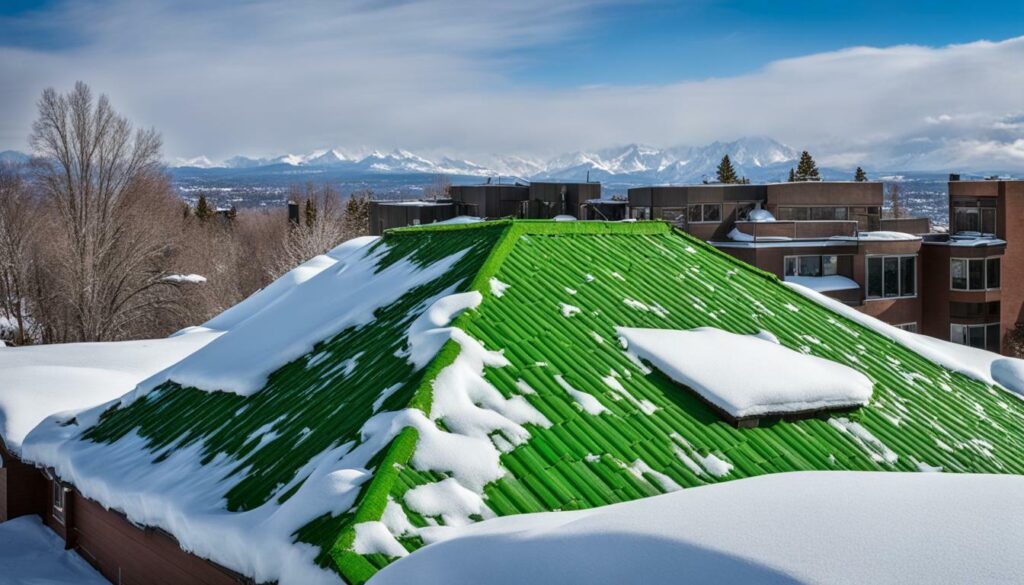
Table: Native Plant Species for Green Roofs in Denver’s Climate
| Plant Species | Benefits |
|---|---|
| Sedum spurium (Dragon’s Blood Stonecrop) | Drought-tolerant, low-growing, red foliage |
| Delosperma cooperi (Ice Plant) | Drought-tolerant, colorful flowers |
| Hedeoma hyssopifolia (Hyssop-leaf False Pennyroyal) | Drought-tolerant, aromatic foliage |
| Eriogonum umbellatum (Sulphur Flower) | Drought-tolerant, yellow flowers |
Source: Denver Botanic Gardens
Conclusion
Green roofs offer a multitude of benefits for urban areas, contributing to sustainability, biodiversity, stormwater management, and overall urban livability. These vegetated roofs provide an innovative solution to some of the environmental challenges faced by cities today. By incorporating green roofs into urban landscapes, cities can create more resilient and sustainable environments.
One of the key advantages of green roofs is their ability to mitigate the urban heat island effect. By absorbing and evaporating heat, green roofs help to reduce temperatures in urban areas, making them more comfortable and cooler. This not only improves the quality of life for city residents but also reduces energy consumption and lowers air conditioning costs.
In addition to cooling cities, green roofs play a crucial role in stormwater management. They absorb rainwater, preventing excess runoff and reducing the strain on urban drainage systems. By retaining and filtering water, green roofs help to improve water quality and prevent flooding, creating a more resilient urban environment.
Green roofs also contribute to urban biodiversity by providing habitats for plants, insects, and birds. By incorporating native plant species into green roofs, cities can support local ecosystems and enhance the natural beauty of their landscapes. This biodiversity not only improves the aesthetics of urban areas but also promotes a healthier and more balanced urban ecosystem.
Furthermore, green roofs can extend the lifespan of traditional roofs by protecting them from the elements, including UV radiation, temperature fluctuations, and freeze-thaw cycles. This not only reduces maintenance costs but also minimizes the need for roof replacements, resulting in long-term cost savings for building owners.
Although green roofs offer numerous benefits, their successful implementation and maintenance require careful planning and consideration. Structural support, proper installation, and regular maintenance are crucial for ensuring their long-term viability. Additionally, in climates like Denver’s, where temperature fluctuations and freeze-thaw cycles are common, selecting native plant species that can withstand these conditions is essential.
As demonstrated by the University of Denver’s green roof project, incorporating green roofs into urban areas is a viable and effective strategy for creating sustainable and resilient cities. By embracing green roof technology, cities can improve their environmental performance, enhance their livability, and promote a greener future for urban communities.
FAQ
Q: What are green roofs?
A: Green roofs, also known as vegetated roofs or living roofs, consist of a waterproofing membrane, soil, and vegetation on top of a traditional roof.
Q: What benefits do green roofs provide?
A: Green roofs provide numerous environmental, social, economic, and aesthetic benefits. They can reduce stormwater runoff, lower energy costs, increase biodiversity, mitigate urban heat islands, extend the lifespan of roofs, and enhance the beauty of buildings.
Q: Do green roofs have a positive cost-benefit analysis?
A: Yes, green roofs have a positive cost-benefit analysis, with potential paybacks and returns on investment.
Q: What are the best practices for green roof installation and maintenance?
A: Best practices include ensuring structural support, proper installation and maintenance, and consideration for historic buildings.
Q: Can you provide a case study of green roof implementation?
A: Certainly! The University of Denver has incorporated a green roof into its Community Commons building, contributing to its sustainability goals and carbon neutrality efforts. The green roof features native plants and serves as a showcase for the campus.
Q: What are the challenges of building and maintaining green roofs in Denver’s climate?
A: Building and maintaining green roofs in Denver’s climate can be challenging due to dramatic temperature changes and freeze-thaw cycles. Careful selection of native plant species is essential to ensure their long-term viability.
